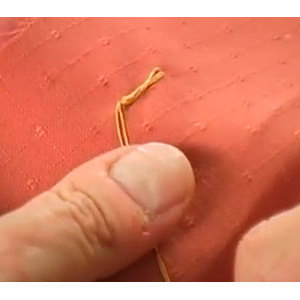
While on the road at the American Sewing Guild conference we caught up with Threads contributing editor Susan Khalje. In this quick video, Susan shares a simple technique for attaching hooks, eyes, and snaps securely to your garments. Try this method to get a couture finish for your garments.
Also, don’t miss Susan’s techniques for sewing thread bars and thread chains.
































So simple! Looks very neat. I will be doing this from now on.
Thanks
what kind of thread is recommended for this task?Thanks!
What a difference a small thing makes! Thank you for this.
Outstanding. I have never mastered the thread chain and she made it look so simple. thank you, Susan.
This is a method I will remember. Never could make my snaps and hooks and eyes look neat. Thinking maybe on some fabric buttonhole twist, single thread, might look neat also. Thanks.
Am using a Kindle Fire and the video is blank.
It's really frustrating! The video is unavailable although I am advised to try again later.
This isn't the first time I've tried to view a Threads video, only to find that I couldn't.
Hey guys, if you're not planning to make a video generally available, don't send us e-mails about it.
Jean
Thank you, that is so neat and gives a good looking finish.
Thank you for another tip from Susan K. I've learned so much from her.
Apparently your videos don't work on iPads either. Get with the times and make videos that everyone can watch!
I am in total agreement with the comments from (Cenimetara)!
Small item - brings about a great technique. Will use always.
My sincere thanks to Ms. Susan Khalje.
Best Regards,
Madisson
The video will not play on my computer, any ideas?
I'm so glad you're finding this useful - sometimes the smallest things make such a difference!
I generally use Gutermann thread - it's smooth as you sew (not grainy or lumpy), and it's available everywhere. I also love silk-finish Mettler cotton, but it's a little harder to find.
I know it's frustrasting, but Apple iPads will not play flash videos, the most used video format. This is a major shortcoming of the iPad and due to a failure to come to an agreement between Apple and Adobe.
Thanks for sharing such a simple, but more effective technique to sew on snaps. I like to see techniques by video.
I like Susan's comments about how couture techniques combine form and function. As an alterations specialist this is a technique that I will definately incorporate into my business. Thanks, Susan, for sharing. Linda at http://www.CustomFitAlterations
Susan: Thank you, so simple, so tidy. I kept thinking there was a better way, but on my own I didn't figure it out.
Our videos do usually work on the iPad, but there was a technical error with this series. This problem has been resolved, and they should work now. Thanks for your patience!
Excellent - thank you! Now, what is the couture way to finish on the back?
What are the parts of the snap called? I have seen "flat part and pokey part" and "male and female". I prefer the the first names, but know that many people, teachers included, use the second. One of our male teachers gave an older stitcher a snap set to attach and specified that the female parts were to be sewn on the overlap side. She looked confused for a second, but looked at the 2 parts and then began to sew. When she was finished and gave him the garment, he said it was all wrong. Turns out that she would never have thought about "male and female" referring to sexual organs. The "pokey part" looked like a woman's breast and she began to sew. And that's why I always call them the pokey and flat parts.
I too would like to know how she finishes the back side, and in addition, I would like to see how to cover snaps with fabric - the couture way. Can we see a video on this?
Re. finishing the back - generally, this technique would be used where there are multiple layers, so that back is covered. Unless they're on terribly light fabric (I'm thinking of something like a single layer of chiffon, for a very lightweight placket), snaps usually go on to multiple layers - you tug on them after all, so the while situation has to be somewhat sturdy.
And I've always referred to the two parts as male and female, and sometimes one hears " ball and socket."
So much neater than my haphazard way. Thank you
I have learned and continue to learn so very much from Susan Khalje. Another simple but elegant and easy tip (once you have the know-how!). Thank you for sharing!
I learned this technique more than 60 years ago in a clothing construction class, taught by Mrs. Lockard, at Madison College (now James Madison U.) in Harrisonburg, VA. At that time we called it the buttonhole stitch and it was the manner in which we made quality buttonholes. Machine-made buttonholes were new on the scene and those attachments didn't always do a good job. Of course, bound buttonholes were also acceptable. Throw the thread counter clockwise, insert the needle in the created space, pull through and you had a locked stitch. We also used it to attach hooks and eyes as well as snaps and I do so to this day.
Thanks so much to Susan K., from one Maryland gal to another. I've learned so very much from you. Linda S.
Great technique! So simple and it holds them on very securely. Thanks for sharing this.